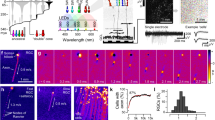Summary
A quantitative model is developed to describe spectral sensitivity functions recorded extracellularly from heterogeneous populations of receptors in different states of adaptation. This treatment identifies the most important influences and clarifies several general features of experimental results.
-
1.
The shapes of retinal spectral sensitivity curves in different states of chromatic adaptation depend in predictable fashion on whether the primary effect of the adapting light on individual receptors is to decreaseV max (response compression) or to increase the quantum demand for half-saturation. Some response compression is necessary in order for one or more receptors to drop out of the response at modest levels of adaptation. The apparent ease of adaptation also depends on the criterion voltage, particularly in the presence of response compression.
-
2.
The technique of selective adaptation of the ERG is capable of revealing the presence of receptors that comprise only a few percent of the total population.
-
3.
The short wavelength absorption of all visual pigments normally makes it impossible to use uv or violet light to adapt selectively those receptors with maximal sensitivity in the uv or violet region of the spectrum while sparing receptors with maximal sensitivity at longer wavelengths. The presence of cone oil droplets absorbing at short wavelengths, however, can effectively screen visual pigments in some of the receptors from uv or violet adapting lights.
Similar content being viewed by others
References
Alpern M, Rushton WAH, Torii S (1970a) The size of rod signals. J Physiol 206:193–208
Alpern M, Rushton WAH, Torii S (1970b) The attenuation of rod signals by backgrounds. J Physiol 206:209–227
Alpern M, Rushton WAH, Torii S (1970c) Signals from cones. J Physiol 207:463–475
Boynton RM, Baron WS (1982) Field sensitivity of the ‘red’ mechanism derived from primate local electroretinogram. Vision Res 22:869–878
Boynton RM, Whitten DN (1972) Selective chromatic adaptation in primate photoreceptors. Vision Res 12:855–874
Brown JE, Coles JA (1979) Saturation of the response to light inLimulus ventral photoreceptors. J Physiol 296:373–392
Brown KT (1968) The electroretinogram: its components and their origins. Vision Res. 8:633–677
Chen D-M, Goldsmith TH (1986) Four spectral classes of cones in the retinas of birds. J Comp Physiol A 159:473–479
Crescitelli F (1965) The spectral sensitivity and visual pigment content of the retina ofGekko gekko. In: Reuck AVS de, Knight J (eds) Colour vision, Ciba Foundation Symposium, Churchill, London, pp 301–324
Dowling JE, Ripps H (1972) Adaptation in skate photoreceptors. J Gen Physiol 60:698–719
Evers HU, Gouras P (1986) Three cone mechanisms in the primate electroretinogram: two with, one without off-center bipolar responses. Vision Res 26:245–254
Goldsmith TH, Bernard GD (1974) The visual system of insects. In: Rockstein M (ed) Physiology of Insecta, vol II, 2nd edn, Academic Press, New York
Goldsmith TH, Fernandez HR (1968) Comparative studies of crustacean spectral sensitivity. Z Vergl Physiol 60:156–175
Goldsmith TH, Collins JS, Licht S (1984) The cone oil droplets of avian retinas. Vision Res 24:1661–1671
Jacobs GH, Neitz J (1986) Spectral mechanisms and color vision in the tree shrew (Tupaia belangeri). Vision Res 26:291–298
Jacobs GH, Neitz J, Crognale M (1985) Spectral sensitivity of ground squirrel cones measured with ERG flicker photometry. J Comp Physiol A 156:503–509
Kleinschmidt J, Dowling JE (1975) Intracellular recordings from gecko photoreceptors during light and dark adaptation. J Gen Physiol 66:617–648
Korth M, Sokol S (1980) Electroretinographic and psychophysical measures of cone spectral mechanisms using the twocolor threshold technique. Vision Res 20:205–212
Menzel R (1971) Über den Farbensinn vonParavespula germanica F. (Hymenoptera): ERG and selektive Adaptation. Z Vergl Physiol 75:86–104
Naka K-I, Rushton WAH (1966) S-potentials from colour units in the retina of fish (Cyprinidae). J Physiol 185:536–555
Neitz J, Jacobs GH (1984) Electroretinogram measurements of cone spectral sensitivity in dichromatic monkeys. J Opt Soc Am A 1:1175–1180
Normann RA, Perlman E (1979) Evaluating sensitivity changing mechanisms in light-adapted photoreceptors. Vision Res 19:391–394
Norren DV (1975) Two short wavelength sensitive cone systems in the pigeon, chicken and daw. Vision Res 15:1164–1166
Norren DV, Padmos P (1973) Human and macaque blue cones studied with electroretinography. Vision Res 13:1241–1254
Wald G (1968) Single and multiple visual systems in arthropods. J Gen Physiol 51:125–156
Author information
Authors and Affiliations
Rights and permissions
About this article
Cite this article
Goldsmith, T.H. Interpreting trans-retinal recordings of spectral sensitivity. J. Comp. Physiol. 159, 481–487 (1986). https://doi.org/10.1007/BF00604168
Accepted:
Issue Date:
DOI: https://doi.org/10.1007/BF00604168




